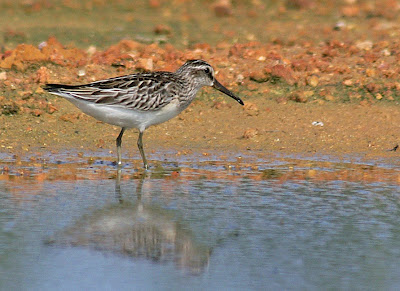The water levels had risen yet again since my last visit, so I had to change the site of my hide once more. I decided not to use my wardrobe as the area was too muddy underfoot.
Once I got into my hide the birds weren't too keen to come close. Maybe it was just too prominent. In any case, I was happy to just watch, having taken as many pics as I wanted to of the commoner species!

First to come close was a number of juv Yellow Wagtails. I was really pleased to be able to photograph them as I've been trying to get good shots of this grey and white version for a few years. Oddly, I mainly see adults in the rice fields.

Some of them came very close indeed. This is practically uncropped.

I really like this shot, even though it's not really sharp. I call it 'Yellow Wagtail with attitude!'

The wader roost out to the side of my hide was almost exclusively Lesser Sand Plovers today, with just a few odds and bobs here and there. Fewer Long-toed Stints than last time, though I did see my first juveniles.
There were even more terns this time - mostly Whiskered, followed in abundance by Little and then White-winged.



I enjoyed the Whiskered Terns against the colourful backdrop of the landfill!

A White-winged Tern looks for a landing space, much to the annoyance of a juvenile Whiskered! The Little Terns don't seem bothered at all.

A couple of immature Purple Herons landed in front of my hide, and spent a very long time pretending to be reeds and peering suspiciously in my direction! Eventually they relaxed somewhat.

I said I wasn't bothered to take more pictures of species I had already photographed many many times, but I just couldn't resist this gorgeous juvenile Lesser Sand Plover - blending in perfectly with the colour of the earth.

I always check for leg flags on the waders. I didn't have any luck today, although I did spot this Marsh Sandpiper which had an aluminium ring on its right tibia.
Having spent about three hours in the hide, I decided to walk down to the southern end of the site to see if there was anything else there.

I flushed about 8 Greater Painted Snipe.

The brighter bird on the right is the female. I must set up the hide to photograph these on the ground one of these days, when the migratory waders have gone!

This male settled on the sand, where it sat looking impossibly front heavy!
As I found out two weeks ago when researching the status of Pectoral Sandpiper in Malaysia, Dr Wells says of Sharp-tailed and Pectoral Sandpiper "Together, hardly more than vagrant, with only nine records from Pattani Bay and the Kedah/Perlis border south to Singapore." So, having seen a Pectoral Sandpiper here on my last visit, what would be the chances of seeing a Sharp-tailed today??

Whatever the odds, a Sharp-tailed Sandpiper was sitting right in front of me!

Rather subtly different from Pectoral Sandpiper, the distinguishing features of an adult 'Sharpie' include a different head pattern - a supercilium that flares behind the eye instead of being more prominent in front, a rather plain crown that presents a capped appearance, chevron-shaped markings down the flanks and on the vent, a more distinct eye-ring, a less distinct cut off between breast and belly, and a rather pot-bellied body shape.


Here's the Pectoral Sandpiper (below) from Sept 12th for comparison.
Having shifted the birds around a bit I scanned through the Sand Plover flock one last time before calling it a day, and picked out a juvenile Little Stint, the first I've seen in Malaysia. All the birds I saw last season and have seen so far this season have been adults in either breeding or non-breeding dress, and I have been wondering how easy it might be to pick out a worn juvenile.




The bird was rather richly marked above compared to juv Red-necked, with the upper rows of scapulars having quite chestnut fringes, and the scapulars and mantle seemed darker centred than juv Red-necked. Perhaps because of this, the 'V' on the mantle stood out far more obviously than on any Red-necked I have seen. The streaking on the breast sides was more coarse than on juv Red-necked, and the crown was darker, without the paler sides to the crown. A split supercilium was fairly prominent. Apart from these plumage features, the differences in bill and leg structure, body and head shape and size noted on adults were also noticeable on this bird.
So the landfill delivered the goods once again. Let it not be said that this particular landfill is a load of rubbish!






































